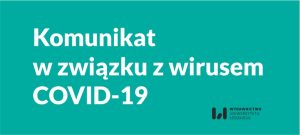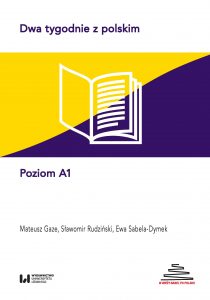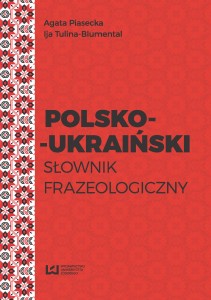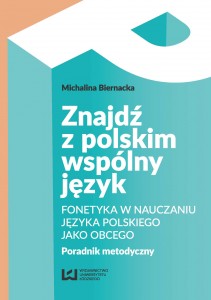Anthropological Review | Vol. 85 No. 3
Opublikowano: 27 października 2022
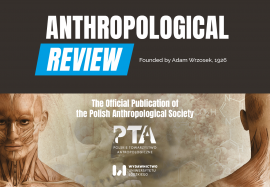
Anthropological Review (dawniej Przegląd Antropologiczny i Przegląd Antropologiczny – Anthropological Review) to oficjalna publikacja Polskiego Towarzystwa Antropologicznego wydawana przez Wydawnictwo Uniwersytetu Łódzkiego. Czasopismo ma długą tradycję publikowania od momentu założenia w 1926 roku przez wybitnego polskiego antropologa fizycznego i lekarza Adama Wrzosa. Czasopismo ukazuje się kwartalnie przy wsparciu finansowym Ministerstwa Nauki i Szkolnictwa Wyższego RP. Od 1997 roku, Anthropological Review publikuje w języku angielskim i jest czasopismem naukowym poświęconym zagadnieniom antropologii fizycznej (m.in. zmienność biologiczna człowieka, wzrost i rozwój człowieka, paleoantropologia, biologia szkieletu, antropologia stomatologiczna) oraz dziedzinom pokrewnym (m.in. psychologia, biologia teoretyczna, demografia). Czasopismo stara się zatem promować interdyscyplinarne spojrzenie na człowieka.
Redaktorem naczelnym czasopisma jest Profesor Sławomir Kozieł (ORCID).
W numerze 85/3:
Agnieszka Tomaszewska, Daniel Psonak, Joanna Rudzka
Aim: In face anatomy and surgery, variation in the presence, number, location, and size of the mental foramen is discussed. Knowledge of the location of the mental foramen canal, which may led due to the possibility of accidental injury of the neurovascular bundle passing through this canal may lead to anesthesia. This study aimed to present selected anatomical features of human mandibles, focusing on the morphology of the mandibular canal and its neurovascular bundle exit in populations with different socio-economic status.
Material and methods: Selected well preserved and unharmed human skulls (N= 169) (50.3% males, 49.7% females) from two populations (rural and outskirts) from Poland were used. Populations differed in socioeconomic statuses.
Results: Obvious dimorphic differences in each analyzed population were stated and inter-population differences were observed as well. In an outskirt population sexual dimorphism was more evident. Those differences should be considered when approaching the mandibular canal during anesthetic, surgical and forensic procedures.
Discussion: The occurrence of the mental foramen is relatively constant, but location is variable, and thus, each individual may exhibit a different arrangement of bundle exits. Both the position and the direction of the exit of the neurovascular bundle were similar to other European population. However, differences in localization between those two investigated populations were observed. This may suggest that not only genetic but also environmental factors, such as living conditions and diet (which affects developmental stability), may influence the morphology of the mandibular features.
Gabriel Babula, Wojciech Czarny, Zofia Ignasiak, Raja Chakraborty, Slawomir Koziel
Objective: This study examined whether there were significant changes (expectedly increase) in BMI (Body Mass Index), and relative subcutaneous body fat during the four years of study in a university and compared these changes between the students of different courses, viz., Computer science, Law and administration, Humanities and Physical education.
Design: This was a prospective follow up study with measurements at two time points with gap of four years. Body mass index, Triceps, subscapular, mid-axillary, abdominal, supra-illiac and medial-calf skinfold thicknesses were measured at two points of time, just after entrance to university and again after completion of four years. Student’s T-test, one-way ANOVA, and repeated measures ANNOVA (two-way) were employed to assess significance of differences in anthropometric measures between groups of students.
Setting: The study was conducted at the University of Rzeszów, Poland.
Participants: 191 young men university students aged approximately 19.5 years and 24.0 years, at the beginning and after four years, respectively, during this study.
Results: Students of all courses underwent increments in BMI, absolute- and relative skinfold thicknesses, except that the students of physical education course did not show change in skinfold thicknesses relative to BMI.
Conclusions: It has been concluded that the change in the adiposity profile during the years of study at university varied according to the course types. Further, detailed studies on the nature and cause of such variation occurring between course types may lead to better understanding etiology of overweight and obesity before entering to adult life.
Aneta Anna Omelan, Krzysztof Borysławski, Robert Stanisław Podstawski
Introduction: Studies conducted in various regions of the world have indicated that physical activity level, body composition and socioeconomic variables can be associated. Therefore, the objective of this study was to determine whether socioeconomic factors are associated with level of physical activity and differences in the body composition of elderly people living in north-eastern Poland.
Materials and Methods: The study involved 774 older residents (60 years or more). Physical activity levels were measured with the International Physical Activity Questionnaire. The respondents’ body composition was determined with an InBody 270 analyser. Pairs of means were compared with Student’s t-test; more than two means were compared with one-way ANOVA; and proportions were compared with the chi-square test. Statistical significance was defined as p≤0.05.
Results: The marital status of men and women was significantly associated with differences in physical activity level and body composition. The place of residence and level of education of women (but not of men), were also significantly associated with differences in body composition. Age and material situation were not significantly associated with differences in body composition and physical activity level.
Conclusion: The mean values of parameters of body composition in the surveyed group exceeded the norms. The level of physical activity of the subjects is at a sufficient level, but in the case of women it depends on socio-economic characteristics. Therefore, there is a need to find effective ways to support older adults in maintaining (or increase) their physical activity with a particular focus on women.
Alicja Drozd-Lipińska, Arkadiusz Bartczak, Michał Krzemiński, Tomasz Dziki
Mortality crises are periods of unusually high mortality resulted from a combination of epidemic episodes, climatic phenomena, historical events and sociopolitical factors. The most pronounced setback in the methodology applied to analyse mortality rates of historical populations is the inability to establish their size.
Reference publications do not provide unambiguous measures of the intensity and scale of mortality crisis periods. This problem was approached with the use of the Standardised Demographic Dynamics Rate (SDDR) whose value provides information about the condition of a population, disregarding the size of the group. Demographic crises were indicated and identified among the population living in the 19th century in central Poland in the rural parish. The analysis was based on data obtained from parish registers, made use of the measure expressing the ratio of the number of births to the number of deaths, without using the size of the group.
Results obtained from the analysis of data were set against the information about events causing a sudden growth in mortality derived from the widely-accessible literature. Value of the Standardised Demographic Dynamics Rate (SDDR) provides information about the condition of a population, disregarding the size of the group. Nevertheless, only by combining the statistically obtained data with the information derived from written records it is possible to attempt to answer the question of the possible root cause of a demographic crisis.
Birgit Bühler, Sylvia Kirchengast
Musculoskeletal stress markers allow the reconstruction of occupational and habitual activity patterns in historical populations. The so-called horse-riding syndrome summarizes several musculoskeletal markers which are commonly interpreted as indicators of habitual horse riding. The individual symptoms of the horse-riding syndrome, however, are still critically discussed. The skeletal remains of mounted warriors are especially suited for the analysis of skeletal markers commonly associated with a life on horseback. According to historical sources, early medieval Avar warriors were highly skilled in mounted archery and other types of mounted combat. An “equestrian lifestyle”, with many hours per day spent on horseback, was presumably a precondition for this. Hence, the historical and archaeological context of the human osteological material examined in this study is a particular asset for analyzing the so-called “horse-riding syndrome”.
The aim of this study is to contribute to methodological research on the “horse-riding syndrome”, by testing possible associations between different characteristics of this syndrome within the adult population of the Avar cemetery Csokorgasse (7th-8th century AD) from Vienna, Eastern Austria. 149 Avar adult individuals (72 females and 77 males) were included in the study. Poirier´s facets, cribiform changes, plaque, as well as five qualitative traits of the Os coxae and the lower limb bones, the index of ovalization of the acetabulum (IOA), and the entheses robusticity score (ERS) were determined.
Males and females differed significantly in the prevalence of Poirier´s facets, cribriform changes, and gluteal entheses. Furthermore, males showed significantly higher IOAs and ERS than females. Significantly positive associations between quantitative and qualitative traits of the horse-riding syndrome could be documented. Poirier´s facets, pronounced gluteal entheses, the index of ovalization of the acetabulum (IOA), and the entheses robusticity score were significantly related independent of sex and age. From the results of the present study we can conclude, that the association patterns between three major characteristics of the “horse-riding syndrome”, i.e. “Poiriers Facet” on the proximal femur, ovalization (vertical elongation) of the acetabulum, and pronounced entheses on the bony pelvis and the lower limb bones – typical markers of the “horse-riding syndrome” – may indeed be a valid set of traits for detecting habitual horse riders in archaeological contexts.
Osteoarthritis in early modern population from Dąbrówki (Podlaskie Province)
Anna Kątniak, Joanna Podladowska, Joanna Wawrzeniuk, Jacek Tomczyk, Zbigniew Wyżewski, Anna Myszka
The aim of this analized is to evaluate the frequency of osteoarthritis in the early modern population of Dąbrówki (Poland). Evaluation of degenerative joint changes was based on standard methods commonly used in physical anthropology. Three types of changes were studied: osteophytes, porosities, and eburnations. They were analyzed in the shoulder, elbow, wrist, hip, knee, and proximal ankle joints. Osteoarthritic changes were assessed in 24 female, 20 male, and 8 undetermined sex individuals in the Dąbrówki population.
In the population from Dąbrówki the highest frequency of degenerative changes was noted in the hip joint, and the lowest in the knee joint. Osteophytes were the predominant type of lesions. The less frequent type was porosity, while polishing of the articular surfaces did not occur. In males, degenerative changes were noted more frequently than in females. Due to the existence of many interpretative limitations (there is no a complete picture of the population from Dąbrówki – skeletal material under exploration; not entirely clear and multifactorial etiology of degenerative joint changes), further analysis of the markers of environmental stress in the population from Dąbrówki is necessary.
Marek Kociuba , Tomasz Kulik, Raja Chakraborty, Zofia Ignasiak, Andrzej Rokita, Slawomir Koziel
Human females demonstrate higher religiosity than men in populations. Digit ratio (2D:4D), being a putative indicator of prenatal testosterone, is associated in varying degrees with characters that show sexual dimorphism. A small number of studies have indicated that religiosity may be associated with the biological basis of sex differences in humans. The objective of the present study was to ascertain whether 2D:4D in religiously oriented seminary students is different from individuals in other occupations. The study followed a cross-sectional design. Male participants of the study included 13 seminary students, 18 military chaplains and 91 control students from study courses relating to civil occupations. Lengths of second (2D) and fourth (4D) digits and their ratio (2D:4D) for each hand, height and weight were the variables and 2D:4D was the outcome measure. The results demonstrated that the seminary students had significantly higher 2D:4D than both the military chaplains and civil students. The military chaplains had the lowest 2D:4D. The study also revealed that the choice of religious occupation, and for that matter, religiosity, could be linked with the prenatal hormonal environment, particularly lower intrauterine testosterone compared to oestrogen.
Sima Dey, Nitish Mondal, Kaushik Bose
The tribal population (8.6%) is vulnerable to neonatal mortality and morbidity in India. Birth weight is an important decisive factor for most neonatal survival and postnatal development. The present study aims to compare the prevalence and associations of certain socio-economic, demographic, and lifestyle variables with low birth weight (LBW) among tribal and non-tribal populations in India. The present investigation utilized retrospective data of the National Family Health Survey (NFHS-4, 2015–16) among tribal (N=26635) and non-tribal (N=142162) populations in India. Birth weight variation of the newborn was categorized into LBW (<2500 gm) and NBW (≥2500 gm). ANOVA, chi-square (χ2) analysis, and binary logistic regression (BLR) were applied using SPSS (version 16.0). The prevalence of LBW was higher in non-tribal (17.2%) than tribal (13.5%), and the population-specific birth weight was significantly higher in tribal than non-tribal population (p<0.01). Higher tribal population concentration (47.0%) areas has a lower (7.4%) prevalence of LBW in the northeast zone, whereas greater non-tribal population concentration (27.1%) areas was found higher in the central zone (19.2%). The BLR analysis showed that rural habitat, lower educational attainment, lack of own sanitary toilet facility, a lower wealth index, absence of electricity, high pollutant fuel exposure, Hindu and Muslim religion, elevated maternal age at first birth, maternal anemia as well as home delivery of newborn have greater odds for LBW (p<0.05). In India, tribal populations are vulnerable and marginalised; their birth weight is significantly higher than that of non-tribals, and they have a lower prevalence of LBW and higher female birth rates. Mother’s socio-economic status and perceptions towards hygiene and better lifestyles acquired by educational upliftment positively affect the birth weight of the newborn in both the tribal and non-tribal population in India.
Komentarze
Ten post dostępny jest także w języku: angielski


